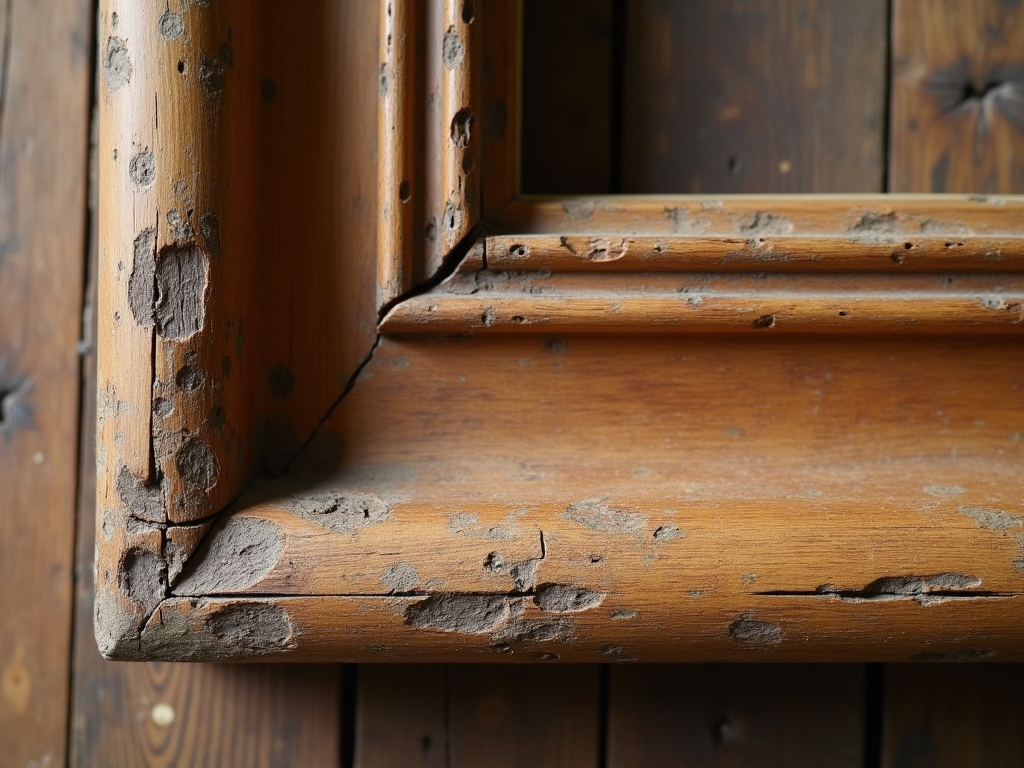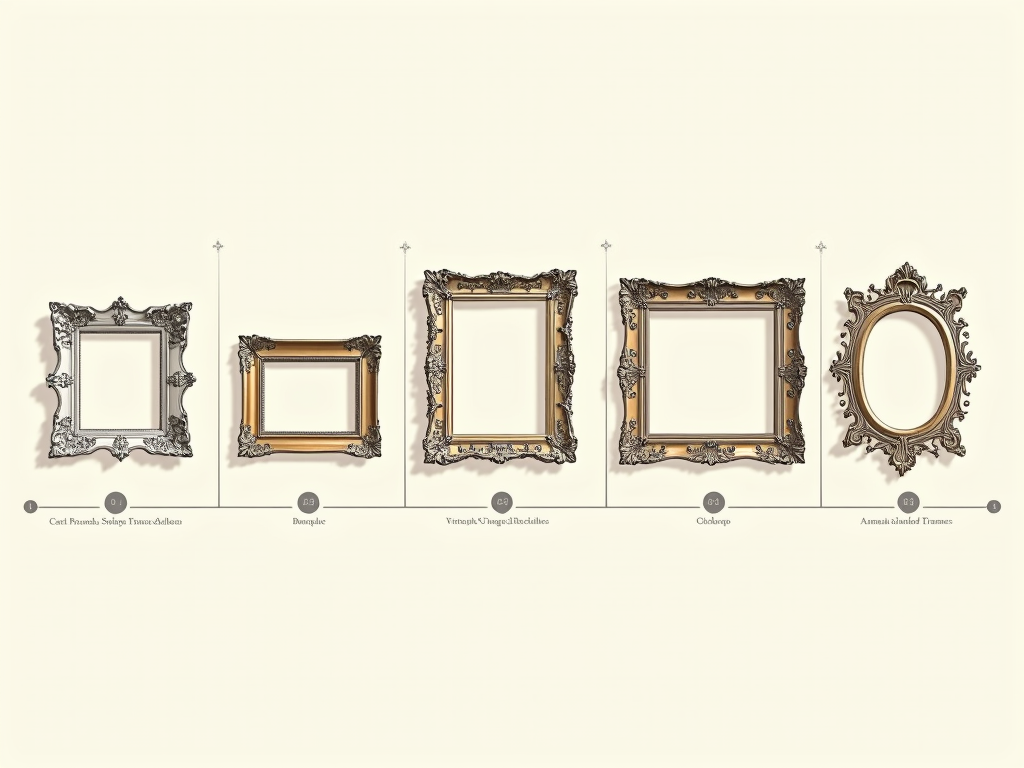
I examine multiple physical characteristics when dating antique picture frames, looking closely at construction methods, materials, and craftsmanship styles. Each era left its distinct mark through specific techniques and available technology. Early frame makers relied on hand-cut joints and wooden splines, while post-1850 frames show the precision of machine manufacturing.
Key Takeaways
- Joint construction types help identify age – hand-cut miter joints were common before 1850, while machine-cut joints appeared afterward.
- Wood type indicates period – early American frames used pine and oak, while the Victorian era favored mahogany.
- Surface treatments reveal age through gesso layering, gilding techniques, and finish types.
- Hardware evolution helps date frames – hand-forged nails and basic screw eyes indicate older pieces.
- Labels and maker’s marks provide direct dating evidence through typography, addresses, and materials used.
I find that examining multiple elements creates an accurate timeline for each frame. By analyzing construction techniques alongside materials and finishes, I can pinpoint specific periods of manufacturing. The shift from handcrafted to machine-made frames marked a significant change in frame production methods, making date identification more precise. Each detail, from wood choice to hardware style, adds another piece to the dating puzzle.
Spot the Tell-Tale Signs of Period Frame Construction
Examining Joint Construction
I’ve found that one of the most reliable ways to date antique picture frames is by looking closely at how they’re joined together. The joints tell a fascinating story about when and how a frame was made. Hand-cut miter joints, commonly used before the 1850s, often show slight irregularities and variations – these imperfections are actually valuable clues to a frame’s authenticity and age.
Early frame makers used simple butt joints, where two pieces of wood were glued together at right angles. This basic technique was popular until the mid-18th century. As craftsmanship advanced, mortise-and-tenon joints became the mark of high-quality frames, offering superior strength and longevity. These joints feature a protruding piece (tenon) that fits into a precisely cut hole (mortise) in the connecting piece.
Machine vs Hand-Crafted Features
The introduction of machinery brought significant changes to frame construction methods. Machine-cut miters, which became common after 1850, display consistent, precise angles and smooth cuts. Here are key features to look for when determining if a frame was machine or hand-crafted:
- Tool marks: Hand-crafted frames often show subtle variations in chisel or plane marks
- Corner alignment: Machine-made frames typically have perfect 90-degree corners
- Surface texture: Hand-finished frames may have slight irregularities in their surface
- Joint gaps: Early hand-cut joints might have small gaps or slight misalignments
- Spline placement: Machine-cut splines show uniform spacing and size
I can spot corner splines and reinforcement methods that also help pinpoint a frame’s age. Early frames often used wooden splines, while later pieces incorporated metal reinforcements. The size and placement of these elements can be crucial dating indicators. Modern frame construction typically uses standardized materials and precise mechanical joining methods.
The back of the frame can be just as revealing as the front. Original backing boards were often rough-sawn wood, while newer frames use manufactured materials. The type of nails or fasteners used to secure the backing can also help determine age – hand-forged nails suggest an earlier period, while uniform machine-cut nails indicate later construction.

Traditional Materials That Date Your Frame
Wood Types and Construction Methods
As a frame expert and picture framing historian, I’ve found that the type of wood used in a frame can quickly narrow down its age. Early American frames showcased the beauty of locally sourced woods – pine and oak were popular choices due to their availability and durability. By the time the Victorian era rolled around, mahogany had become the go-to material, giving frames a rich, sophisticated appearance.
Surface Treatments and Finishes
The telltale signs of age often lie in a frame’s surface treatment. I can spot genuine antique frames by their gesso layering – a traditional mixture of chalk and animal glue that creates a smooth surface for gilding. The history of frame making shows that craquelure patterns (those tiny cracks in the surface) can help pinpoint a frame’s age, as they form distinctive patterns over time.
A significant shift occurred in the late 18th century with the introduction of composition materials, or “compo.” This moldable mixture of chalk, resin, and animal glue let craftsmen create detailed ornamental designs more efficiently than hand-carving.
The gilding technique can also reveal a frame’s age. Water gilding, used in older frames, creates a matte finish that can be burnished to a high shine. It’s a process I’ve studied extensively while learning frame-making techniques. Oil gilding, which appeared later, produces a consistently shiny surface but can’t be burnished.
Different protective finishes mark specific periods:
- Wax finishes were common in earlier frames, giving a soft, natural sheen
- Shellac became popular in the 18th century, offering better protection
- Lacquer finishes emerged later, providing a harder, more durable coating
These protective layers weren’t just practical – they enhanced the frame’s visual appeal and preserved its craftsmanship. When I’m examining an old frame, I look for signs of original finish beneath years of accumulated dirt and wear. These subtle details help me understand traditional framing methods and determine authenticity.
The placement of hanging hardware can also suggest a frame’s age. Older frames often feature hand-forged hooks or rings, while newer ones typically have manufactured hanging systems. I always check these details before deciding how to properly hang historic frames.
Identifying Period Styles and Decorative Elements
Key Historical Periods
Picture frames tell compelling stories through their unique decorative elements, with each era leaving its distinct mark on frame design. I’ve found that historical picture frame styles can be dated by looking at specific artistic features and construction methods.
The Baroque period frames, popular from the 17th to early 18th century, showcase lavish carvings. They’re packed with dramatic scrollwork and shell motifs that catch light and create shadow. Mid-18th century Rococo frames took this decorative spirit further, but with a lighter touch. They’re spotted by their graceful C-scrolls and S-scrolls that seem to dance around the frame’s edge.
Modern Era Characteristics
Moving into the late 18th and early 19th centuries, Neoclassical frames brought a shift to simpler, refined designs. I can spot these by their precise geometric patterns and signature acanthus leaf details. Victorian frames made a dramatic turn back to ornate styling – they’re loaded with composition decorations and often show Gothic Revival influences.
The turn of the 20th century brought fresh perspectives with Art Nouveau picture frames. Here’s what to look for in different modern styles:
- Art Nouveau (late 19th-early 20th century): Natural forms, flowing lines, and plant-inspired motifs
- Art Deco (1920s-1930s): Bold geometric shapes, streamlined designs, and symmetrical patterns
- Mid-Century Modern: Clean lines, minimal decoration, and simple wood constructions
I’d recommend examining the corners closely – they often hold the most telling decorative elements. The craftsmanship details in these areas can help pinpoint the era. Making picture frames has changed dramatically over time, and these changes in construction methods can also help date a piece.

Hardware and Historical Construction Methods
The hardware and construction methods used in antique picture frame construction tell a fascinating story about when they were made. Looking at the hardware gives clear signals about a frame’s age, much like examining the layers of history hidden within its joints and fasteners.
Dating Through Hardware Evolution
I’ve found that early picture frames typically showcase hand-forged nails with distinctive irregular shapes, setting them apart from their modern counterparts. These early frames often relied on basic screw eyes for hanging – a simple yet effective solution that was standard before the 20th century. When I examine frame construction techniques, I look for these telltale signs of age.
The backing materials used in frames changed significantly over time. Here are the key elements I check when dating a frame:
- Wooden panel backs: Common in the oldest frames
- Masonite backing: Started appearing in the mid-20th century
- Hand-forged nails: Irregular shapes indicate pre-1800s construction
- Machine-cut nails: Uniform appearance suggests post-Industrial Revolution
- Screw types: Unslotted screws are oldest, while Phillips-head screws appeared after the 1930s
- Hanging hardware: Simple screw eyes indicate older frames, while D-rings suggest more recent construction
The transition from basic hanging methods to more sophisticated systems mirrors the development of frame-making through history. I pay special attention to the screws used in frame construction—unslotted screws typically indicate the earliest examples, while the presence of Phillips-head screws firmly places a frame in the 20th century or later.
Modern DIY picture framing methods differ greatly from historical techniques. Today’s frames often feature standardized hardware and machine-precise construction, making it easier to spot authentic period pieces. When I’m hanging vintage frames, I’m careful to consider their original hardware limitations and often need to make subtle modifications to ensure they’re secured safely on modern walls.
The evolution of nails offers another reliable dating method. Hand-forged nails, with their characteristic irregular heads and shanks, suggest pre-industrial craftsmanship. Machine-cut nails, displaying uniform shapes and sizes, point to production after the Industrial Revolution. This shift in manufacturing processes creates clear markers for dating frames from different periods.
Authentication Through Labels and Markings
Understanding Frame Labels
Labels and markings tell a fascinating story about a picture frame’s past. I’ve found that framemaker labels can be a treasure trove of information, much like historical picture framing techniques themselves. These small paper tags often contain the craftsman’s name, workshop address, and sometimes even a date – crucial details for pinning down a frame’s origin.
Artist and gallery labels add another layer to a frame’s story. These stickers or stamps can link the frame to specific exhibitions, collections, or notable artists. The way these labels are printed, their typography, and paper quality can point to specific time periods. For instance, handwritten labels with copper plate script often indicate Victorian-era craftsmanship.
Analyzing Historical Indicators
The inscription style on frame labels holds valuable dating clues. I can spot different historical periods through:
- Typography characteristics unique to specific decades
- Business addresses that changed over time
- Registration numbers or maker’s marks
- Paper quality and printing methods used
- Adhesive types used to attach the labels
To verify a frame’s age through its markings, I turn to historical business directories, trade records, and museum archives. These resources help trace framemakers’ business locations and operating dates. The physical characteristics of labels matter too – yellowed paper, particular printing techniques, and specific adhesive types can confirm authenticity. Some antique picture frame origins can be traced through maker’s marks stamped directly into the wood or plaster.
The position of labels can also indicate authenticity. Original frame labels typically appear on the back of the frame, while gallery labels might be found on both front and back. It’s worth noting that fraudulent labels exist, but authentic ones often show consistent aging patterns matching the frame’s overall condition.

Sources:
The Gilded Edge: The Art of the Frame by Eli Wilner
Looking at European Frames: A Guide to Terms, Styles, and Techniques by D. Gene Karraker
In Perfect Harmony: Picture + Frame, 1850-1920 by Eva Mendgen, et al.
A Closer Look: Frames by Nicholas Penny
